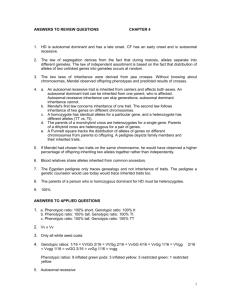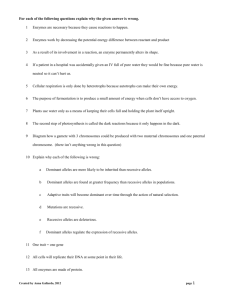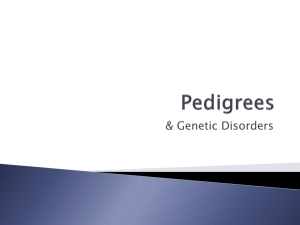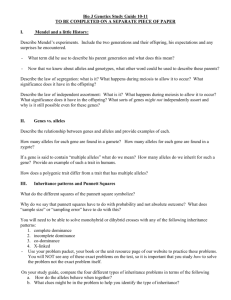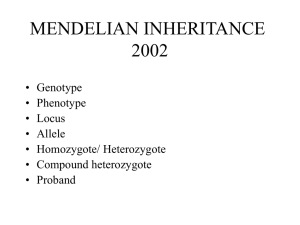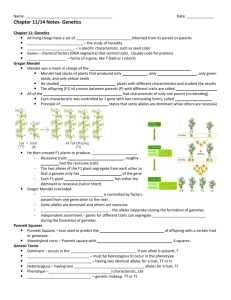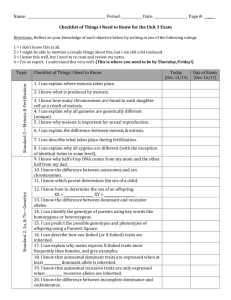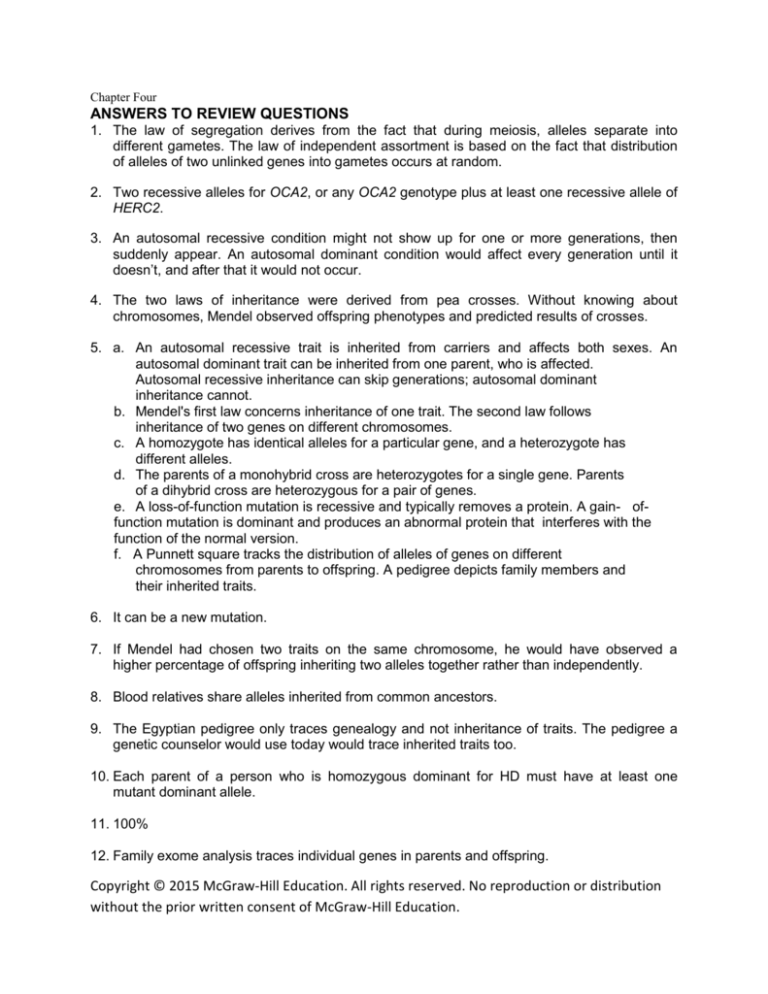
Chapter Four
ANSWERS TO REVIEW QUESTIONS
1. The law of segregation derives from the fact that during meiosis, alleles separate into
different gametes. The law of independent assortment is based on the fact that distribution
of alleles of two unlinked genes into gametes occurs at random.
2. Two recessive alleles for OCA2, or any OCA2 genotype plus at least one recessive allele of
HERC2.
3. An autosomal recessive condition might not show up for one or more generations, then
suddenly appear. An autosomal dominant condition would affect every generation until it
doesn’t, and after that it would not occur.
4. The two laws of inheritance were derived from pea crosses. Without knowing about
chromosomes, Mendel observed offspring phenotypes and predicted results of crosses.
5. a. An autosomal recessive trait is inherited from carriers and affects both sexes. An
autosomal dominant trait can be inherited from one parent, who is affected.
Autosomal recessive inheritance can skip generations; autosomal dominant
inheritance cannot.
b. Mendel's first law concerns inheritance of one trait. The second law follows
inheritance of two genes on different chromosomes.
c. A homozygote has identical alleles for a particular gene, and a heterozygote has
different alleles.
d. The parents of a monohybrid cross are heterozygotes for a single gene. Parents
of a dihybrid cross are heterozygous for a pair of genes.
e. A loss-of-function mutation is recessive and typically removes a protein. A gain- offunction mutation is dominant and produces an abnormal protein that interferes with the
function of the normal version.
f. A Punnett square tracks the distribution of alleles of genes on different
chromosomes from parents to offspring. A pedigree depicts family members and
their inherited traits.
6. It can be a new mutation.
7. If Mendel had chosen two traits on the same chromosome, he would have observed a
higher percentage of offspring inheriting two alleles together rather than independently.
8. Blood relatives share alleles inherited from common ancestors.
9. The Egyptian pedigree only traces genealogy and not inheritance of traits. The pedigree a
genetic counselor would use today would trace inherited traits too.
10. Each parent of a person who is homozygous dominant for HD must have at least one
mutant dominant allele.
11. 100%
12. Family exome analysis traces individual genes in parents and offspring.
Copyright © 2015 McGraw-Hill Education. All rights reserved. No reproduction or distribution
without the prior written consent of McGraw-Hill Education.
ANSWERS TO APPLIED QUESTIONS
1. a. Phenotypic ratio: 100% short. Genotypic ratio: 100% tt
b. Phenotypic ratio: 100% tall. Genotypic ratio: 100% Tt
c. Phenotypic ratio: 100% tall. Genotypic ratio: 100% TT
2. Vv x Vv
3. Only all-white seed coats
4. Genotypic ratios: 1/16 = VVGG 2/16 = VVGg 2/16 = VvGG 4/16 = VvGg 1/16 = VVgg
2/16 = Vvgg 1/16 = vvGG 2/16 = vvGg 1/16 = vvgg
Phenotypic ratios: 9 inflated green pods: 3 inflated yellow: 3 restricted green: 1 restricted
yellow
5. Autosomal recessive
6. Autosomal recessive
7. Pedigree
8. Carriers are I3, I4, II4, III3, III4
9. 1 in 2 chance the child has double eyelashes
1
2
1
2
Copyright © 2015 McGraw-Hill
Education.
All rights reserved. No reproduction or distribution
1
Caleb
without the prior written consent of McGraw-Hill Education.
?
1
10. Consanguinity.
11. a. Uncles and nieces having children together.
b. Carriers = III-5, III-6, III-9, IV-1 and niece (V-1), IV-6, IV-11, V-4, V-5, V-6, V-9, and V-10
12. Genotypic ratios:
4/32 = BbHhEe
4/32 = bbHhEe
2/32 = BbHhEE
2/32 = BbJJEe
2/32 = BbhhEe
2/32 = BbHhee
2/32 = bbHhEE
2/32 = bbHHEe
2/32 = bbhhEe
2/32 = bbHhee
1/32 = BbHHEE
1/32 = BbhhEE
1/32 = BbHHee
1/32 = Bbhhee
1/32 = bbHHEE
1/32 = bbhhEE
1/32 = bbHHee
1/32 = bbhhee
Phenotypic ratios:
9/32 = yellow urine, colored eyelids, short fingers
9/32 = red urine, colored eyelids, short fingers
3/32 = yellow urine, normal eyelids, short fingers
3/32 = red urine, normal eyelids, short fingers
3/32 = yellow urine, colored eyelids, long fingers
3/32 = red urine, colored eyelids, long fingers
1/32 = yellow urine, normal eyelids, long fingers
1/32 = red urine, colored eyelids, long fingers
ANSWERS TO WEB ACTIVITIES
1. Giant axonal neuropathy (see In Their Own Words in chapter 2) affects Hannah Sames, and
her parents are carriers. Her two sisters are either carriers or wild type. Gavin Stevens,
featured in the chapter 5 opener, has a form of Leber congenital amaurosis due to a
recessive mutation on an autosome. His parents are carriers and his brother, like Hannah’s
sisters, are either heterozygotes or have two wild type alleles. Both GAN and Gavin’s LCA
are autosomal recessive.
2. Juvenile HD often causes seizures and progresses faster than the disease in adults, but
symptoms may be intermittent. Adults with HD steadily decline, but a young person might be
unable to walk one week, but able to the next.
3. Kalydeco has cleared patients’ lungs, made their intestinal gas less stinky, and improved
energy levels.
ANSWERS TO FORENSICS FOCUS
1. a. Answers depend on whether one considers spit a body part.
b. Genealogy can reveal family relationships and history but is limited by lapses in memory,
unwillingness to share information and gaps in records. DNA testing can confirm
genealogical information or rule out ancestry but has limitations based on statistics and
probability.
2. Determine the alleles of the two genes that confer eye color (OCA2 and HERC2)
Copyright © 2015 McGraw-Hill Education. All rights reserved. No reproduction or distribution
without the prior written consent of McGraw-Hill Education.
ANSWERS TO CASE STUDIES AND RESEARCH RESULTS
1. ½ x ½ x ½ = 1/8
2. a. Many students will think testing is a good idea, because it can prevent deaths and
testing everyone does not stigmatize members of specific population groups.
b. The NCAA can set standards to avoid the conditions that can result in rhabdomyolysis,
or require evidence of newborn testing for sickle cell disease to avoid unnecessary
duplicate testing.
c. Ensure that student athletes get enough rest and hydration during events, games,
and
practice.
3. a. Geneticists advise against testing people under 18 for HD unless the teens are mature
enough to handle bad news.
b. Autosomal dominant
c. 1 in 2
d. If the fetus inherited HD, so did Peter.
4. a. Family exome sequencing
b. Bea’s condition resulted from a new mutation in either the sperm or egg
c. 1 in 2
5. Protests may be a valuable guide for couples. If a couple finds they are both carriers of
the same recessive trait, they may choose not to have children or even marry.
Constigmatization if an individual’s genetic tests reveal a potential disorder. Testing may
be justified if the goal is to reduce suffering and it remains confidential and voluntary.
Opinion varies and whether and the degree to which researchers and clinicians should
interfere with a culture’s practices concerning reproduction.
Copyright © 2015 McGraw-Hill Education. All rights reserved. No reproduction or distribution
without the prior written consent of McGraw-Hill Education.

